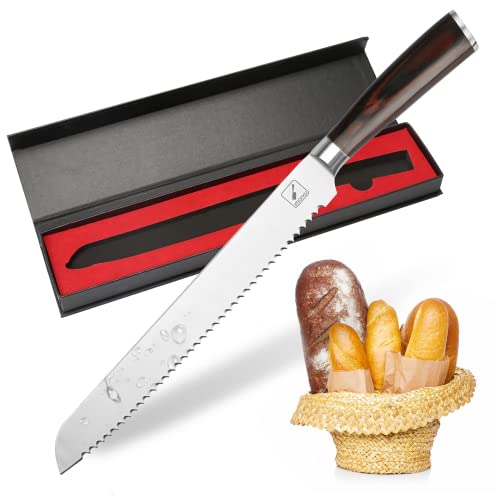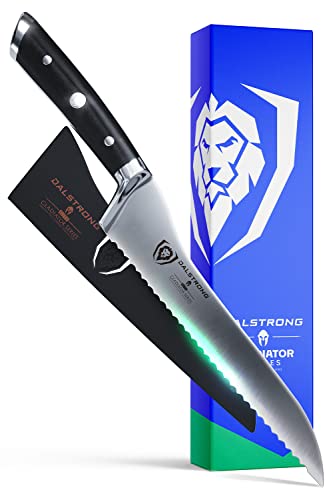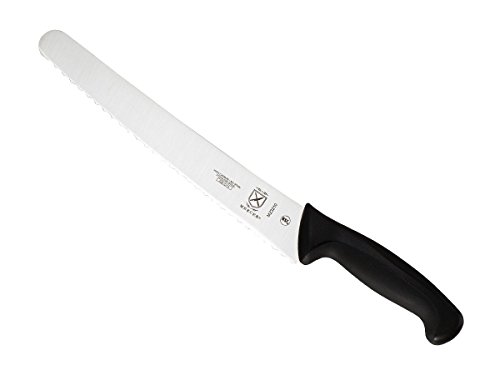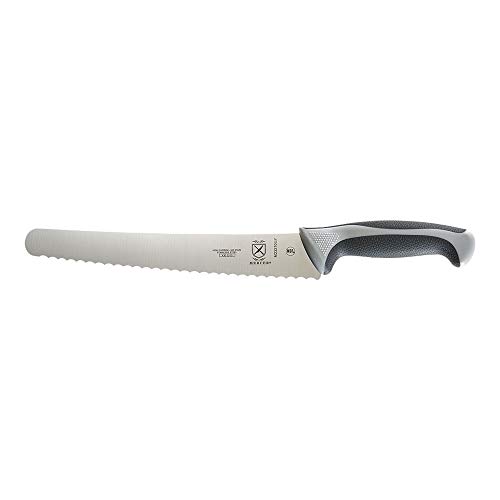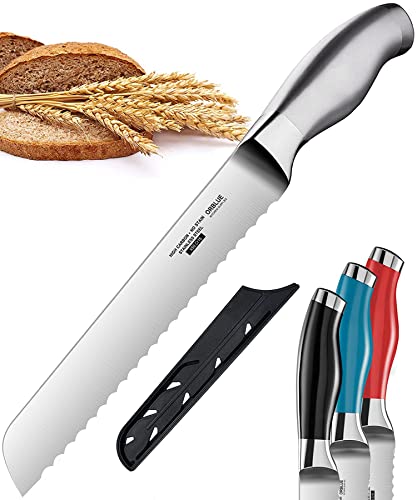- sign in
- Design
- Food
- Pop Culture
- Style
- DIY Classes
The Best Bread Knife to Slice Through Bread Like a Pro
E-Commerce WriterPublished on October 2, 2023Last updated on May 1, 2024With all the tech-savvy gadgets on the block, you might overlook some of the most essential kitchen tools such as the humble bread knife. It's more than just a utensil, it’s a trusted companion that ensures each loaf of bread is sliced to perfection. A top-rated bread knife in 2024 can glide through the crustiest of sourdoughs, slice through delicate brioche, and even make quick work of voluminous artisanal loaves.
These knives are noteworthy because they cater to complex consumer needs, from the novice home baker to the well-seasoned chef, becoming an essential tool in every pantry. So let's find the right knife for you!
Thanks to the imarku Bread Knife, slicing bread is a task you look forward to. This German high-carbon stainless steel bread knife performs at a professional-grade level. Its ten-inch and serrate...
read moreImportant Features- High-carbon stainless steel material
- Ten-inch blade length
- Ergonomic wood handle design
Level up your bread-slicing game with the Dalstrong Serrated Offset Bread Knife! It's an elite addition to the Gladiator Series and comes with an impressive eight-inch blade. Ideal for slicing th...
read moreImportant Features- Black G10 handle with triple riveting
- Full-tang, high-carbon German steel blade
- Hand-polished edge
- Geometrically angled serrations
Behold the Mercer Culinary M23210 Bread Knife. With an impressively sharp ten-inch wide wavy edge, it makes slicing through crusty baguettes and soft brioche a piece of cake (or should we say bre...
read moreImportant Features- Constructed with high-carbon Japanese steel
- Features a one-piece design for durability
- Ergonomic handle with textured grip points
- Boasts a wavy edge for precise slicing
The Mercer Culinary Millennia Bread Knife is a top-notch addition to your kitchen arsenal. What makes it stand out is its ten-inch wavy edge blade, designed for optimal bread slicing. Say goodbye to...
read moreImportant Features- Crafted with high-carbon Japanese steel
- One-piece knife construction
- Ergonomic handle with textured finger points
- Non-slip grip for enhanced safety
- Wavy edge blade design
The Orblue Serrated Bread Knife is not just your typical bread knife, it's a must-have kitchen tool. With its superb quality and upgraded stainless steel razor sharp wavy edge width, it's the bes...
read moreImportant Features- Ultra-sharp serrated eight-inch blade
- Five-inch ergonomic handle
- Rubber safety guard on tip
- High quality and 2.2 millimeters thick
How To Pick the Bread Knife for Your Kitchen
Choosing the best bread knife might not seem like the most challenging task, but like every gadget, informed decisions must be made regarding this overlooked kitchen tool. Remember, the right bread knife can elevate your everyday bread-slicing experience from a mundane task to a pleasurable ritual. And you might think, pleasurable? Well, there’s something undeniably satisfying about slicing through a crusty loaf of bread. The crunch, the aroma, the anticipation of that first bite, it’s almost therapeutic!
Getting down to it, these utensils come in various shapes, sizes, and materials. They usually feature a long, slender blade with a serrated or scalloped edge designed to gently saw through the bread without exerting downward pressure that can crush the loaf. They are versatile tools and can be used for other tasks like slicing tomatoes, peaches, or anything else that is soft on the inside and has a tougher exterior. Armed with this comprehensive guide, you can make an informed choice that suits your needs and budget.
Blade Type
The blade is the heart of any knife, and these utensils are no exception. The most common types you’ll find are serrated and scalloped blades. Serrated blades, with their jagged edges, are powerhouses when it comes to cutting through hard crusts. However, they can be a bit aggressive for softer breads, causing them to tear. Scalloped blades, on the other hand, have smoother and rounder edges that can glide through both hard and soft breads with ease. Your choice between the two usually depends on the type of bread you frequently consume.
Blade Length
Blade lengths for bread knives typically range from eight to 12 inches. Shorter blades provide better control and precision, making them ideal for smaller loaves, buns, and rolls. Longer blades are designed to tackle bigger tasks, allowing you to slice through a large loaf in a single stroke without having to saw back and forth. Therefore, if you’re a home baker who loves making large loaves, a longer blade would be more suitable.
Handle Design
The handle is your point of contact with the knife, so its design significantly impacts the ease and safety of use. Look for handles that offer a comfortable grip and won’t slip out of your hand when wet. Traditional wooden handles add a touch of elegance to your kitchen toolset but can become slippery. Modern bread knives often feature rubberized or plastic handles that offer a secure grip and are sometimes ergonomically designed to reduce hand fatigue.
Material
These knives are typically made from high carbon stainless steel, stainless steel, or ceramic. High carbon stainless steel is renowned for its sharpness, durability, and rust resistance but can be on the pricier side. Stainless steel is more affordable and still does a decent job, but it may not hold its edge as long. Ceramic knives are incredibly sharp and lightweight but require careful handling as they can be brittle and prone to chipping.
Price
Just like any other product, bread knives come in a wide range of prices depending on the brand, material, and craftsmanship. While it might be tempting to go for the cheapest option, keep in mind that a good knife is an investment. It’s better to shell out a bit more for a knife that will last you years and make your bread-slicing experience enjoyable.
Comparing the Top Bread Knives of 2024
Best Overallimarku Bread Knife
Thanks to the imarku Bread Knife, slicing bread is a task you look forward to. This German high-carbon stainless steel bread knife performs at a professional-grade level. Its ten-inch and serrated edge is sheer excellence, slicing through crusty homemade bread with the utmost ease. The blade’s high-grade steel composition ensures longevity and sharpness, making it a kitchen essential.
But it’s not just about the slicing. The knife’s balance and handle are equally impressive. It achieves an uncompromised balance between weight and control. The handle is designed for a comfortable grip that allows for accurate, clean cuts with minimal effort, whether you’re dealing with a cake or crusty bread. Using it will give you the confidence that no bread, however crusty, can pose a challenge. It’s our overall best due to its quality, great price, sleek design, and ease of use.
Pros- High-quality German steel blade
- Perfect balance and comfortable weight
- Effortless slicing through hard bread
Cons- Sharp blade can cause nicks
Best for Artisan BreadDalstrong Serrated Offset Bread Knife
Level up your bread-slicing game with the Dalstrong Serrated Offset Bread Knife! It’s an elite addition to the Gladiator Series and comes with an impressive eight-inch blade. Ideal for slicing through all types of bread, especially artisan varieties that are notoriously difficult to cut. Fashioned from forged German high-carbon steel, this slicing knife is a true champ when it comes to strength and durability.
The bread slicer’s unique offset handle provides a comfortable grip that promotes precise, effortless cuts with every use. Your fingers will thank you for the extra space between the blade and the cutting board. The quality of this bread knife is backed by NSF certification, so you can rest assured you’re getting a top-notch product. And the G10 handle is a delight, boasting superior durability that ensures this knife will last. Plus, the knife comes with a sheath for safe storage!
Pros- Comfortable weight and balance
- Cuts bread with minimal effort
- Works well for all bread types
Cons- This knife is a little expensive
Best for Long-TermMercer Culinary M23210 Bread Knife
Behold the Mercer Culinary M23210 Bread Knife. With an impressively sharp ten-inch wide wavy edge, it makes slicing through crusty baguettes and soft brioche a piece of cake (or should we say bread?).
The standout feature has to be its efficient serrated blade, perfect for versatile cutting. Whether it’s a hearty country loaf or a delicate tomato, this blade guarantees clean, effortless cuts every time without crushing or squashing your food. But it’s not just about the blade. The knife’s black handle offers a comfortable and secure grip, meaning it feels just as good to hold as it looks. Crafted with the demands of today’s chefs in mind, this bread knife is a culmination of performance meets innovation. It’s also a top choice for long-term use! So consider this knife an investment.
Pros- Effective on both soft and hard foods
- Comfortable ergonomic handle
- Safety features to prevent slips
Cons- Handle may be too grippy for some
The Mercer Culinary Millennia Bread Knife is a top-notch addition to your kitchen arsenal. What makes it stand out is its ten-inch wavy edge blade, designed for optimal bread slicing. Say goodbye to squashed or mangled bread slices, this knife will cut through even the toughest crusts and the softest insides with equal ease.
Another standout feature is the comfortable ergonomic handle. Long bread-slicing sessions won’t feel like a chore anymore, as the handle fits perfectly in your hand, reducing fatigue and increasing your control over the blade. The knife provides excellent value for money, with a performance that can easily compete with far more expensive brands. It’s designed with professional chefs in mind but can be equally useful in any home kitchen. The gray color adds a sleek, modern vibe, ensuring this knife won’t just be tucked away in a drawer. It truly brings together functionality and aesthetics.
Pros- Comfortable and non-slip handle
- Lightweight yet sturdy design
- Easy to sharpen and maintain
Cons- Not suitable for dishwasher
Most AffordableOrblue Serrated Bread Knife
The Orblue Serrated Bread Knife is not just your typical bread knife, it’s a must-have kitchen tool. With its superb quality and upgraded stainless steel razor sharp wavy edge width, it’s the best thing since sliced bread! It gives you that smooth, clean cut every time, making a tedious chore enjoyable.
This gem also comes with a unique wavy edge design, the best-scalloped edge knife you can find in the market. It’s ideal for slicing homemade bagels and cakes, and its eight-inch blade coupled with a five-inch handle promises a comfortable grip and easy maneuvering. Trust us, this bread knife doesn’t just do the job, it does it with finesse. Whether you’re a home cook or a professional chef, you’ll appreciate the difference this tool can make.
Pros- Unique “wavy” edge for easy cutting
- High-quality, solid handle
- Excellent balance for precision
Cons- Difficult to get straight cuts
Bread Knife FAQs
Q: What is a bread knife?A: These utensils are kitchen tools with sharp, serrated blades designed to cut through bread with minimal crumbs and without squashing the loaf.
Q: What are bread knives also useful for?A: These knives are not only used for cutting bread, but also for slicing soft fruits and vegetables, such as tomatoes, as the serrated edge allows for easy slicing without squishing.
Q: How do I clean and maintain my bread knife?A: Cleaning one usually involves washing it by hand with mild soap and warm water, then drying it immediately to prevent rusting. Avoid putting it in the dishwasher as the high heat and harsh detergents can damage the knife. For maintenance, sharpening usually isn't necessary as they have a serrated edge that stays sharp for a long time.
Q: Why is my bread knife not cutting cleanly?A: If your knife is not cutting cleanly, it may be due to dullness or bread crust hardness. However, these knives rarely get dull because of their serrated design. Check if you're using the right technique, a sawing motion, rather than pushing down.
Q: How do I safely use a bread knife?A: To safely use one of these utensils, hold the knife by the handle and use a sawing motion to cut, rather than trying to push the knife down through the bread. Also, it's important to always cut on a stable surface and keep your fingers away from the blade to avoid accidents.
Q: How long does a bread knife typically last?A: The lifespan depends on its quality, how often it's used, and how well it's maintained. High-quality ones, when properly cared for, can last for many years.
Q: Why is my bread knife rusting?A: They can rust if not properly maintained. This usually happens when the knife is not dried properly after washing.
We may earn a commission if you make a purchase through one of our links. The newsroom or editorial staff was not involved in the creation of this content.Natalie is a graduate from the Ohio State University where she studied English. She edits content about lifestyle and education. In her free time, she enjoys trying new recipes, reading in the park, and exploring her city of Columbus, Ohio.

